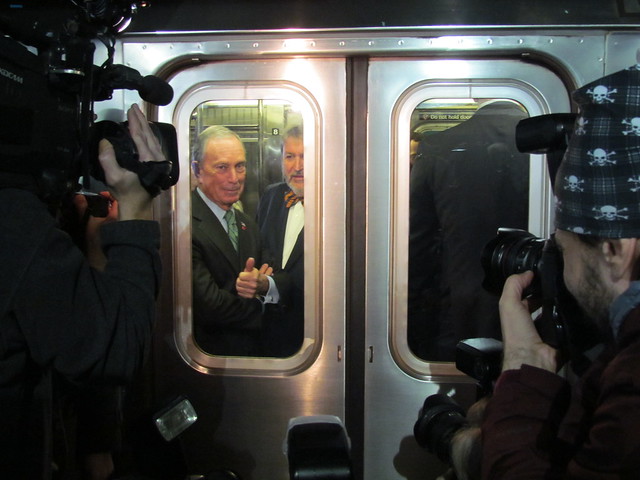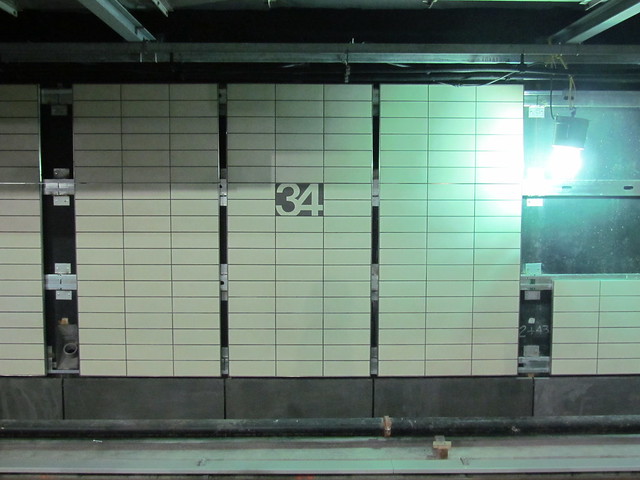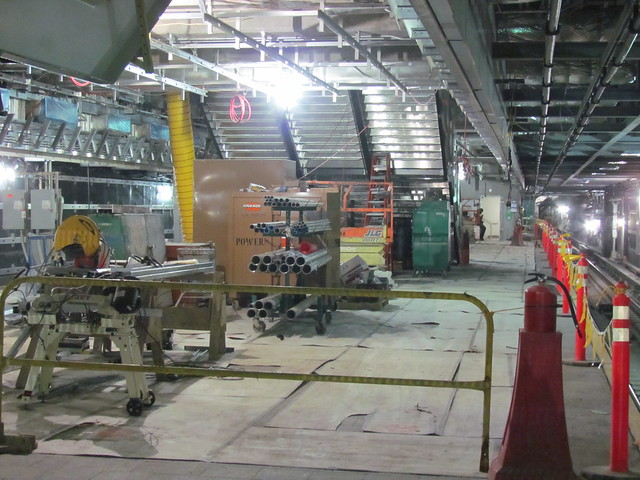
Mayor Bloomberg flashes a thumbs up as his 7 train heads east from 34th St. and 11th Ave. (Photo: Benjamin Kabak)
The 7 line extension down to 11th Ave. and 34th St. isn’t quite what I’d call ready for passengers. In some spots, the floor is down; in some areas — conveniently behind the train that pulled in carrying the mayor this afternoon — the wile tiling is there. But mostly, it’s a station without finishes. Wiring, paneling, ceilings, walls and floors: None of it is in place yet, and it doesn’t have to be. The opening date for the station, perhaps optimistically, isn’t until June of 2014.
Still, with Mayor Bloomberg’s tenure up in a little bit more than a week, he wanted the opportunity to talk about his contributions to New York City. It wasn’t quite a ribbon-cutting; that will come when the station is complete. But it was a ceremony as a 7 train rolled down the tracks from 42nd St. to deliver the mayor to the station he helped see through with $2.4 billion in city money. Since this was, after all, the first city-funded subway extension since the Queens Boulevard line went east to Jamaica-179th Street in 1950, the mayor, flanked by his daughters, wanted to be there himself to see something through. I don’t blame him.
Press materials distributed by the Mayor’s Office today spoke about how the extension “demonstrates the commitment by the Bloomberg Administration to invest in infrastructure projects that will ensure New York City continues to be a leading global city in the future.” For a one-stop subway extension priced at $2.4 billion, the pomp and circumstance was almost too much, and when Bloomberg dropped an “on time and on budget” reference into his remarks, I shed a tear for our dearly departed station at 41st St. and 10th Ave. Yet, in the mayor’s comments, what he said about investment rang true.
The mayor, who flashed his senior MetroCard, admitted to “virtually never taking the bus” and spoke about how he rides the subway often, spoke about the need to invest in infrastructure. New York City, he noted, will not have more streets, and it is going to be even more dependent on mass transit. Yet, the transportation network hasn’t kept pace with the growth of the city. “We stopped building subways,” he said, “but the population keep moving.”
In his remarks, Bloomberg touched upon areas I’ve covered over the years. He spoke about subway service deeper into Brooklyn, extending lines into eastern Queens and a connection for Staten Island. He talked about he need to renovate and overhaul the city’s aging airports, and he discussed how he expects congestion pricing to one day return and pass. “There will never be a time,” he said, “when you don’t have the opportunity or necessity to expand infrastructure.”
Through it all, I thought about my lukewarm embrace of Bill de Blasio and if he truly understands the need to focus on infrastructure expansion, but I also thought on Bloomberg’s past 12 years. He seems to get the role mass transit plays, and his contributions — Select Bus Service, borough taxis, Citi Bikes, pedestrian plazas — have been multi-faceted. But considering how many areas could use a subway extension, even of a stop or two, and how there are no firm plans on the horizon for more capital work after Phase 1 of the Second Ave. Subway wraps, I wondered if we had missed some good opportunities to exploit shorter expansions to deliver better service for New Yorkers. We don’t always need to build full lines; even just 2.5 miles down Utica Ave., for instance, would make a big difference.
So today the 7 line had its moment in the sun, but it’s debut is a while away. The wall tiling is up only where the Mayor’s train pulled in, and the floor isn’t in place everywhere. Work remains to be done on the mezzanine and platform, but it’s coming along. And when it opens and tens of thousands of people a day start using this new station, the Far West Side won’t be so far after all.
After the jump, a slideshow of all of my photographs from today. You can find a few more on my Instagram account as well.



17 comments
$2.4 billion. For less than that light rail could have gone from Penn Station, Javitts then down the High Line instead of a park with railroad track to trip on. But then the Bloonberg administration ripped up the streetcar track laid in Red Hook.
no
Yes, it’s true, that might have been technically possible.
But none of that is remotely a substitute for SAS.
The tracks on the High Line have been built into the pathway for the most part. Plus in Manhattan I’m pretty sure the NIMBYs would have easily won a battle to reactivate an old elevated from the era of creaky, squeaky steel after decades of disuse.
Not denying that the price has been exorbitant for one stop (and one scrapped stop), just throwin’ out some Facts(tm).
Phase II of the SAS needs to be built. If for no other reason than to provide some redundancy for the East Side and the Bronx in case of an issue with the Lex, and for Fasttrack.
Here is what I would do if I were the city. I’d say the MTA could build the second phase of the SAS with the connection to the Lex and Metro North, and the Rutgers/DeKalb connection, for $2 billion the city would borrow and pay for it. But for every dollar over $2 billion that is spent, regardless of the source, the city would take a dollar away, so it would contribute nothing if the projects cost $4 billion. And it would take $20 million away for every worker killed or crippled on the job.
The MTA would have to bid it out that way, design-built with coverage for over-runs. Then it would be up to the contractors. Do it for that, or don’t do it at all.
What us the Rutgers/Dekalb connection?
How deep is this station? (from street level)
one story I read today said 18 stories – but not sure if that’s true.
Is there a plan to build a spur line down Utica Ave? I hadn’t heard of that. I’ve read so many times on this blog that it’s wildly more expensive to build subways here than even in expensive cities like Paris. Assuming that’s true and that Europeans aren’t fudging the accounts to make things look cheaper than they actually are, couldn’t someone–the governor, the new mayor–propose some changes that any new projects would have to conform to? Like what Larry Littlefield does above, but more comprehensive. I’d like to see a new line out into the farthest reaches of eastern Queens from Houston street, if anyone is listening.
Not so much a plan as a defunct proposal. Google “IND Second System.” Or Wiki it, I guess. Utica Avenue was a proposed back in the day, as were numerous other extensions. Provisions were actually made for many of these lines, including Utica Avenue.
As for changes, I suppose the mayor could propose land use rule changes and the governor could propose work rule changes. Neither seem very interested.
You are absolutely right that line down utica was propsed. If you are ever Utica Ave Station on the A and C line, I believe you can see remnants of some sort of shell station there. Its interesting that Ben used Utica ave as an example of a possible short extension, as opposed to maybe a slightly more likely extension such as Nostrand Ave, which has tracks running there for a good portion of the street already.
Weren’t the archer avenue line and the 63rd street line built in the 80’s?
Both lines opened in the late 80’s, but construction on the Archer Ave line started in 1972, and on the 63rd st line in 1969
Wouldn’t that still make both of them much newer than the 1950 extension referenced in the article as the last extension to the subway system?
They were not city-funded. You’re overlooking the key adjective in that sentence.
Ohhhh. Of course! Thanks for the clarification. I should have realized that.
This is by far the most expensive place to build subways! Do we have the money to build out these kinds of projects? Why is it so expensive in Manhattan to build out?